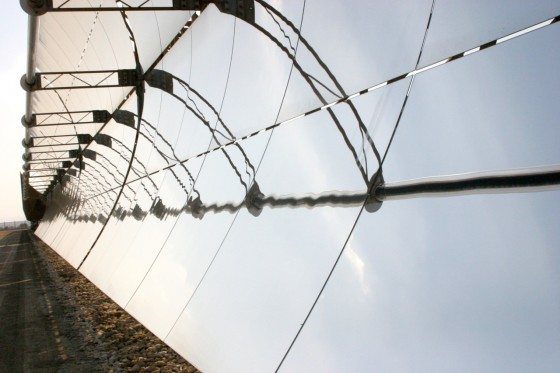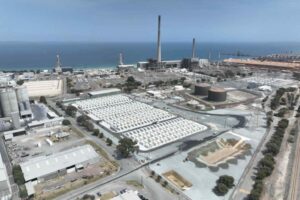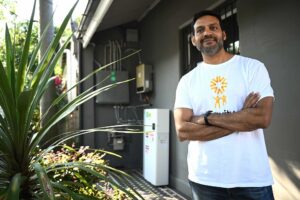A new report outlining the prospects of solar thermal energy has underlined its enormous potential for Australia, saying it could provide between a third and even one half of the nation’s energy needs, but notes it may require a new of thinking about energy production and delivery.
The report, entitled, “Realising the potential of Concentrating Solar Power in Australia”, says that solar thermal technology is behind wind energy and solar PV in terms of deployment and costs, but could play a critical role because it’s energy can be stored and dispatched when needed. Not only that, but Australia also as the potential to parlay its excellent R&D into a significant stake in the global supply chain, and it could even end up being an exporter of renewable energy, rather than just fossil fuels.
The report predicts that 2GW of solar thermal could be built by 2020, with 15GW deployed in the near to medium term. That would account for up to 30 per cent of the country’s total generation capacity. However, its potential could be even greater, if the best resources remote from the grid could also be tapped, it was conceivable that solar thermal could provide half of the country’s energy need by 2050.
Solar thermal is different from solar PV used in household rooftop systems because rather than using modules to generate electricity, solar thermal uses mirrors or lenses to concentrate solar energy onto a single point or linear receiver, and use that energy to create steam and drive a turbine. It also lends itself to storage, allowing energy to be dispatched at time of peak demand, or even overnight.
This report covers what is known as concenetrated solar power (CSP), which includes concentrated solar PV as well as solar thermal. Australia has been a leading innovator in CSP technology, with Ausra (now owned by Areva), pioneering the compact linear Fresnel reflector technology, the ANU developing solar dish technology that will be used in the Whyalla Solar Oasis project, and numerous technology breakthroughs at the CSIRO solar facility near Newcastle. The first demonstration plant of Australian developed CPV technology will be unveiled in Bridgewater, Victoria, later this month.
“With CSP exploiting its world-leading solar resources, Australia can claim a significant place in the global clean energy supply chain,” it says, noting that this is a unique opportunity because Australia does not hold such a stake in other clean energy alternatives. “Delaying action will see that opportunity missed,” it notes.
The CSP industry is confident it can follow the success of wind energy and solar PV and achieve a significant fall across the cost curve. The report estimates that the average cost of CSP is around $250/MWh (similar to some recent renewable auction bids in South Africa) but it argues that this can fall to $120-$130/MWh – where its ability to provide dispatchable power. (See separate story for explanation on costs).
The report says that CSP plants could be configured with or without thermal storage. This means that in the 15GW scenario, which would require minimum grid upgrades, the energy potential ranges between 25,000 and 60,000 GWh per year (equivalent to 8 to 20% of current annual electricity demand).
Its roadmap, see table below, suggests that Australia could reach the stage in a few decades when it is actually exporting electricity to Asia. As outlandish as this concept may be, such grids are being considered in Europe – where the Desertec Initiative is looking to export solar power from north Africa, and is now under discussion in Japan, which is looking to export solar and other renewable sources from Mongolia.
The report says systems could be configured to offer combinations of immediate generation when solar is available (no thermal storage), energy on-demand using storage or co-firing, or continuous generation at lower power level using storage or co-firing.
The report lists CSP’s advantages as providing dispatchable energy, to complement other renewable energy sources with variable outputs, the ability to be integrated into existing new coal and gas power plants, and the fact that it need not compete for productive land or valuable water. It would create jobs – every 100MW of system would create around 500 job years during construction and 20 jobs during operation, mostly in regional areas – and 10 GW of capacity would reduce Australia’s emissions by roughly 30 Mt CO2 per year, or over 15% of electricity sector emissions.
But, the technology does face challenges, outlined in the table below. Mostly this is about finding the “value proposition” and delivering the right incentives to help bring the technology down the cost curve.
It suggests a series of measures, ensuring that financing is available for early deployment, the creation of solar-CSP precincts, and leverage its considerable R&D expertise, with a focus on targeting deployment of systems below 50 MW (overlooked by the global industry), incorporating energy storage, improving efficiency and hybridisation with fossil fuel plants, as well as using advanced cooling technologies.
However, Keith Lovegrove, one of the lead authors of the report, suggests that to fully embrace technologies such as solar thermal, policy makers and grid operators needed to move beyond the concepts and practices that had dominated the industry in recent decades, particularly the obsession with “baseload” and “peak-load” power.
“Baseload is only a term used by someone wanting to criticize something,” Lovergrove told RenewEconomy. “It’s basically an outmoded concept. It’s a term invented to keep some power stations busy.
“The thing about the energy future is to match supply to demand at all times. Smart meters will allow people to decide how to manage demand. People in the business of energy supply can decide how to manage that. CSP with storage is well suited to that.”
Lovegrove says there is enormous potential for CSP to come down the cost curve. But CSP did not need to match the current cost of “baseload” coal because it would not be competing in the same market. “The reason you would bother with CSP is that it is dispatchable, so the incentives we put in place should recognize that.”











